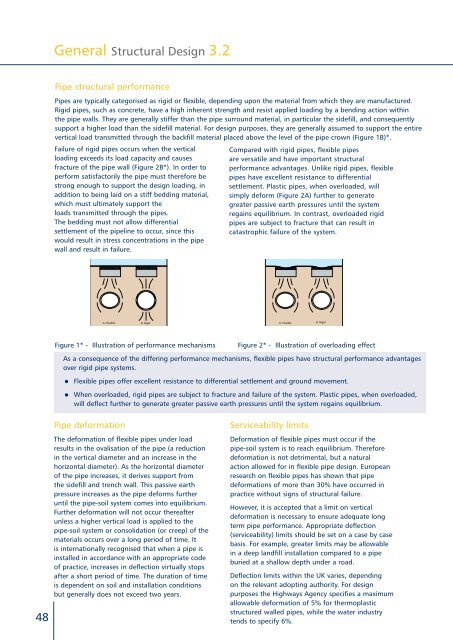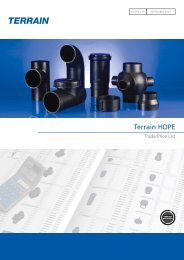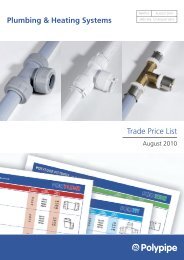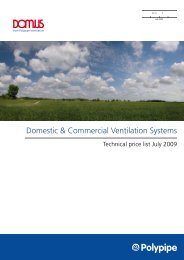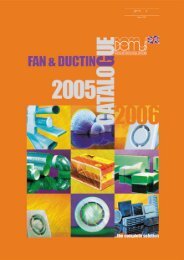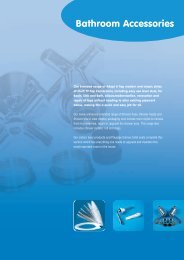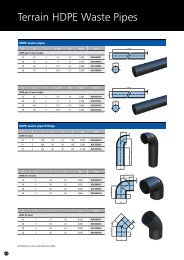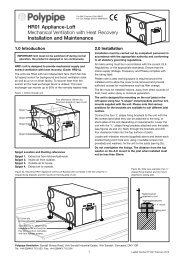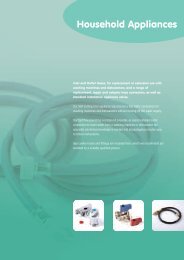advanced drainage system - Polypipe
advanced drainage system - Polypipe
advanced drainage system - Polypipe
Create successful ePaper yourself
Turn your PDF publications into a flip-book with our unique Google optimized e-Paper software.
General Structural Design 3.2<br />
Pipe structural performance<br />
Pipes are typically categorised as rigid or flexible, depending upon the material from which they are manufactured.<br />
Rigid pipes, such as concrete, have a high inherent strength and resist applied loading by a bending action within<br />
the pipe walls. They are generally stiffer than Compressible Board the pipe surround material, Compressible in Board particular the sidefill, and consequently<br />
Trench<br />
Trench<br />
Support<br />
Support<br />
support a higher load than the sidefill material. For design purposes, they are generally assumed to support the entire<br />
Compressible Board<br />
Compressible Board<br />
vertical load transmitted through the backfill material placed above the level of the pipe crown (Figure 1B)*.<br />
Failure of rigid pipes occurs when the vertical<br />
100mm<br />
loading exceeds its load capacity and causes<br />
fracture of the pipe wall 150mm (Figure 150mm 2B*). In order to<br />
perform satisfactorily the pipe must therefore be<br />
strong enough to support the design loading, in<br />
addition to being laid on a stiff bedding material,<br />
150mm<br />
150mm<br />
150mm<br />
which must ultimately support the<br />
200mm<br />
200mm<br />
200mm<br />
loads transmitted through the pipes.<br />
150mm<br />
150mm<br />
The bedding must not allow differential<br />
settlement of the pipeline to occur, since this<br />
100mm<br />
would result in stress concentrations in the pipe<br />
150mm 150mm<br />
150mm<br />
wall and result in failure.<br />
1ess than 1.2m<br />
Minimum 150mm<br />
150mm<br />
1ess than 1.2m<br />
1ess than 1.2m<br />
Minimum 150mm<br />
150mm<br />
150mm<br />
150mm<br />
150mm<br />
150mm<br />
Compared with rigid pipes, flexible pipes<br />
100mm<br />
are versatile and have important structural<br />
performance advantages. Unlike rigid pipes, flexible<br />
pipes have excellent resistance to differential<br />
settlement. Plastic pipes, when overloaded, will<br />
simply deform (Figure 2A) further to generate<br />
150mm<br />
greater passive earth pressures until the <strong>system</strong><br />
200mm<br />
regains equilibrium. In contrast, overloaded rigid<br />
Concrete<br />
Concrete<br />
Grade<br />
150mm<br />
C20<br />
150mm<br />
Grade C20<br />
pipes are subject to fracture that can result in<br />
catastrophic failure of the <strong>system</strong>.<br />
100mm 150mm<br />
1ess than 1.2m<br />
150mm<br />
150mm<br />
150mm<br />
A. Flexible B. Rigid<br />
A. A. Flexible B. B. Rigid Rigid<br />
A. Flexible<br />
B. Rigid<br />
Figure 1* - Illustration of performance mechanisms<br />
Figure 2* - Illustration of overloading effect<br />
As a consequence of the differing performance mechanisms, flexible pipes have structural performance advantages<br />
over rigid pipe <strong>system</strong>s.<br />
• Flexible pipes offer excellent resistance to differential settlement and ground movement.<br />
•<br />
When overloaded, rigid pipes are subject to fracture and failure of the <strong>system</strong>. Plastic pipes, when overloaded,<br />
will deflect further to generate greater passive earth pressures until the <strong>system</strong> regains equilibrium.<br />
48<br />
Pipe deformation<br />
The deformation of flexible pipes under load<br />
results in the ovalisation of the pipe (a reduction<br />
in the vertical diameter and an increase in the<br />
horizontal diameter). As the horizontal diameter<br />
of the pipe increases, it derives support from<br />
the sidefill and trench wall. This passive earth<br />
pressure increases as the pipe deforms further<br />
until the pipe-soil <strong>system</strong> comes into equilibrium.<br />
Further deformation will not occur thereafter<br />
unless a higher vertical load is applied to the<br />
pipe-soil <strong>system</strong> or consolidation (or creep) of the<br />
materials occurs over a long period of time. It<br />
is internationally recognised that when a pipe is<br />
installed in accordance with an appropriate code<br />
of practice, increases in deflection virtually stops<br />
after a short period of time. The duration of time<br />
is dependent on soil and installation conditions<br />
but generally does not exceed two years.<br />
Serviceability limits<br />
Deformation of flexible pipes must occur if the<br />
pipe-soil <strong>system</strong> is to reach equilibrium. Therefore<br />
deformation is not detrimental, but a natural<br />
action allowed for in flexible pipe design. European<br />
research on flexible pipes has shown that pipe<br />
deformations of more than 30% have occurred in<br />
practice without signs of structural failure.<br />
However, it is accepted that a limit on vertical<br />
deformation is necessary to ensure adequate long<br />
term pipe performance. Appropriate deflection<br />
(serviceability) limits should be set on a case by case<br />
basis. For example, greater limits may be allowable<br />
in a deep landfill installation compared to a pipe<br />
buried at a shallow depth under a road.<br />
Deflection limits within the UK varies, depending<br />
on the relevant adopting authority. For design<br />
purposes the Highways Agency specifies a maximum<br />
allowable deformation of 5% for thermoplastic<br />
structured walled pipes, while the water industry<br />
tends to specify 6%.


